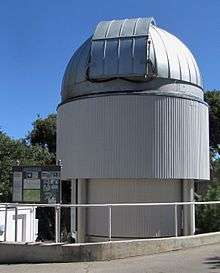CHARA array
 | |
| Alternative names |
CHARA |
|---|---|
| Location(s) | Mount Wilson, California, US |
| Coordinates |
34°13′29″N 118°03′26″W / 34.22469°N 118.05712°WCoordinates: 34°13′29″N 118°03′26″W / 34.22469°N 118.05712°W |
| Organization |
Georgia State University |
| Telescope style |
Optical telescope |
| Website |
www |
 Location of CHARA array | |
The Center for High Angular Resolution Astronomy (CHARA) is an optical interferometric array, owned by Georgia State University (GSU), and located on Mount Wilson, California. It is the most powerful interferometer in the world.[1] Anyone wanting to apply for time at the array can by following the instructions at CHARA’s website.
Functionality
CHARA’s six telescopes each have a one-meter diameter mirror to reflect light. They are spread across Mount Wilson to increase the angular resolution of the array. Each of the six telescopes provides a different image, to combine it into one image the light from each telescope is transported through vacuum tubes and fed into a single beam, where they are matched up to within one micron. This process is called interferometry, and allows the array to have the same resolving power as a telescope with a 330-meter mirror, and an angular resolution of 200 micro-arcseconds.[1][2]
History
In 1984 CHARA was founded, and with financial support from the National Science Foundation (NSF), in 1985 planning for the array began. Construction for the array started on July 13, 1996, and with $6.3 million awarded to GSU by the NSF, and the same amount matched by GSU, going towards the effort. In July 1998, GSU was awarded another $1.5 million by W.M. Keck Foundation, which allowed for a sixth telescope to be added to the previously planned five. With a final gift of $574,000 from David and Lucile Packard Foundation, the funding for the array was completed in October 1998.[3]
After another five years of construction, the CHARA array was completed in 2003. In April of the same year, CHARA was awarded a 3-year grant to support scientific programs at the center, which was renewed in 2006.[3] In 2013 another grant from the NSF worth 3.6 million was given to the Center.[4]
Discoveries
On January 15, 2007, the diameter of an exoplanet was measured directly, using CHARA. This was achieved by using the observed angular diameter of the star that the planet orbited, and the already known distance of the star from earth, to get the diameter of the star. With this they could calculate the diameter of the exoplanet when comparing its size to the star when it passed in front of it. This was the first time the diameter of an exoplanet was directly measured, and returned a value slightly different than that obtained from indirect, more conventional methods.[5]
In 2013 CHARA was used to capture images showing the starspots on Zeta Andromedae, a star 181 light years away. This was the first time that images of starspots on stars other than our sun has been taken, and the spots acted differently then that of those on our sun.[6][7]
Events
CHARA holds annual science meetings where they discuss and review recent advancements in science and technologies relevant to the array.
The center also gives open access of the array to the astronomical community using the NOAO peer review system around 50 nights per year. They also have periodic community workshops.
See also
- 1 2 "About". www.chara.gsu.edu. Retrieved 2017-10-26.
- ↑ Hand, Eric (2010-04-07). "Telescope arrays give fine view of stars". Nature News. 464 (7290): 820–821. Bibcode:2010Natur.464..820H. doi:10.1038/464820a.
- 1 2 Baron, Fabien. "History of CHARA". www.chara.gsu.edu. Retrieved 2017-10-26.
- ↑ "CHARA Array awarded $3.9 million to provide telescope access to scientists across the nation". EurekAlert!. Retrieved 2017-10-26.
- ↑ "CHARA measures an exoplanet". Astronomy.com. Retrieved 2017-10-26.
- ↑ "'Starspot' Images that Give Insight into Early Sun Captured by University's CHARA Telescope Array - News Hub -". News Hub. 2016-05-04. Retrieved 2017-10-26.
- ↑ "Seeing Stars | DiscoverMagazine.com". Discover Magazine. Retrieved 2017-10-26.